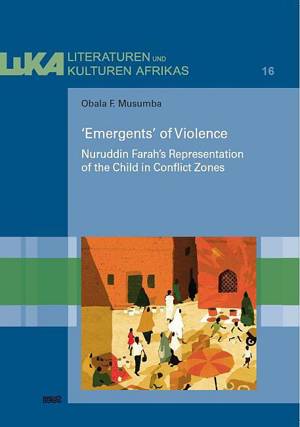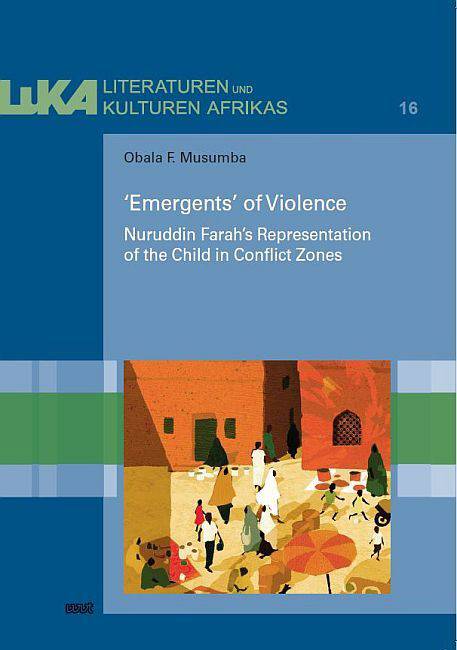
- Afhalen na 1 uur in een winkel met voorraad
- Gratis thuislevering in België vanaf € 30
- Ruim aanbod met 7 miljoen producten
- Afhalen na 1 uur in een winkel met voorraad
- Gratis thuislevering in België vanaf € 30
- Ruim aanbod met 7 miljoen producten
Zoeken
'Emergents' of Violence: Nuruddin Farah's Representation of the Child in Conflict Zones
Obala F. Musumba
€ 29,95
+ 59 punten
Omschrijving
This book critically analyses the representation of the child character in Nuruddin Farah's Past Imperfect trilogy which consists of the novels Links, Knots and Crossbones. The book focuses on Farah's fictionalization of the child character in a violent Somalia by highlighting the nexus between violence, childhood and the postcolonial nation as represented in Farah's art of novel writing. By reading the current state of a split-up Somalia through postcolonial lenses, the child is being centred as a symbol for entangled conflicts, identity constructions and projections into future. The book also engages selected novels by a younger generation of authors illuminating the plight of the child subject in times of war in Eastern African states such as Somalia, Kenya, Rwanda, Uganda, and Burundi. It reveals that the violent conflicts experienced in this region mediate the emergence of an ambivalent child of violence; a child who bears the brunt of violence and also unleashes violence upon the society. This child of violence is thus critical in defining the kind of society that is responsible for her/his emergence. S/he portends a unique form of hopelessness in the society and by contrast also as a ray of hope for the reconstruction of a new state that would be free of violence and that appeals to everyone.
Obala F. Musumba holds a PhD degree from the Institute of Asian and African Studies, Humboldt University of Berlin. Currently, he is a lecturer of Comparative Literature at Bomet University College in Kenya.
Contents
Acknowledgementsxi
Introduction1
Part I: Theoretical and Contextual Preliminaries7
1. The Somali Worldview7
1.1 Political and Cultural Liminality in Somalia7
1.2 Somali Orality14
1.3 Somali in the Islamic Purview16
1.4 Being a Somali Child20
2. Theorising and Narrating Violence in Postcolonial Africa27
2.1 Postcolonial Theory28
2.2 Rooting Postcolonial Violence in Colonialism30
2.3 Traumatic Aftermath44
2.4 A Narratological Reading of the Past Imperfect Trilogy48
3. Nuruddin Farah: Chronicling Somalia's Politics through Fiction52
3.1 Nuruddin Farah53
3.2 The Art of Trilogy Writing57
3.3 Overviews, Childhood and Violence in the Past Imperfect Trilogy66
3.4 A Fourth Trilogy? New Identities and Displacement in Hiding in Plain Sight and North of Dawn71
Part II: Forms and Functions of Children of the Somali Conflict Zone(s) in Nuruddin Farah's Past Imperfect Trilogy78
4. The Child Character in the Interstices of Public and Private Space in the Past Imperfect Trilogy78
4.1 The Dialectics of Peace in the Time of War78
4.2 Idyllic Symbol(s) and Representations86
5. The Flight Motif in the Past Imperfect Trilogy95
5.1 Martyrdom in Islam97
5.2 Dying in Order to Live: The Ambiguity of Death in Islam99
5.3 Mitigating Factors for Flight100
5.4 Linguistic Mapping of Zones of Contests107
5.5 Beyond the Horizons of Diaspora in Crossbones109
6. The Dilemma of the Child Character in the Past Imperfect Trilogy114
6.1 Childhood at Risk115
6.2 Mediating Spaces between Clan, Nationality, and Globality117
6.3 In the Midway of Returning and Staying121
7. Narrating the Child and Farah's Critical Social Vision125
7.1 Retelling the War Narrative126
7.2 Evaluating Farah's Critical Social Vision131
Part III: Comparative Readings: Children in Diasporic Somali and Eastern African Literatures139
8. Nuruddin Farah and Contemporary Somali Diaspora Novel139
8.1 Somali Literature: Transitioning from Orality to Written Literature140
8.2 Entanglement of Migration, Identity, and Trauma in the Contemporary Somali Novel
Obala F. Musumba holds a PhD degree from the Institute of Asian and African Studies, Humboldt University of Berlin. Currently, he is a lecturer of Comparative Literature at Bomet University College in Kenya.
Contents
Acknowledgementsxi
Introduction1
Part I: Theoretical and Contextual Preliminaries7
1. The Somali Worldview7
1.1 Political and Cultural Liminality in Somalia7
1.2 Somali Orality14
1.3 Somali in the Islamic Purview16
1.4 Being a Somali Child20
2. Theorising and Narrating Violence in Postcolonial Africa27
2.1 Postcolonial Theory28
2.2 Rooting Postcolonial Violence in Colonialism30
2.3 Traumatic Aftermath44
2.4 A Narratological Reading of the Past Imperfect Trilogy48
3. Nuruddin Farah: Chronicling Somalia's Politics through Fiction52
3.1 Nuruddin Farah53
3.2 The Art of Trilogy Writing57
3.3 Overviews, Childhood and Violence in the Past Imperfect Trilogy66
3.4 A Fourth Trilogy? New Identities and Displacement in Hiding in Plain Sight and North of Dawn71
Part II: Forms and Functions of Children of the Somali Conflict Zone(s) in Nuruddin Farah's Past Imperfect Trilogy78
4. The Child Character in the Interstices of Public and Private Space in the Past Imperfect Trilogy78
4.1 The Dialectics of Peace in the Time of War78
4.2 Idyllic Symbol(s) and Representations86
5. The Flight Motif in the Past Imperfect Trilogy95
5.1 Martyrdom in Islam97
5.2 Dying in Order to Live: The Ambiguity of Death in Islam99
5.3 Mitigating Factors for Flight100
5.4 Linguistic Mapping of Zones of Contests107
5.5 Beyond the Horizons of Diaspora in Crossbones109
6. The Dilemma of the Child Character in the Past Imperfect Trilogy114
6.1 Childhood at Risk115
6.2 Mediating Spaces between Clan, Nationality, and Globality117
6.3 In the Midway of Returning and Staying121
7. Narrating the Child and Farah's Critical Social Vision125
7.1 Retelling the War Narrative126
7.2 Evaluating Farah's Critical Social Vision131
Part III: Comparative Readings: Children in Diasporic Somali and Eastern African Literatures139
8. Nuruddin Farah and Contemporary Somali Diaspora Novel139
8.1 Somali Literature: Transitioning from Orality to Written Literature140
8.2 Entanglement of Migration, Identity, and Trauma in the Contemporary Somali Novel
Specificaties
Betrokkenen
- Auteur(s):
- Uitgeverij:
Inhoud
- Aantal bladzijden:
- 212
- Taal:
- Engels
- Reeks:
- Reeksnummer:
- nr. 16
Eigenschappen
- Productcode (EAN):
- 9783868219753
- Uitvoering:
- Paperback
- Afmetingen:
- 160 mm x 10 mm
- Gewicht:
- 351 g

Alleen bij Standaard Boekhandel
+ 59 punten op je klantenkaart van Standaard Boekhandel
Beoordelingen
We publiceren alleen reviews die voldoen aan de voorwaarden voor reviews. Bekijk onze voorwaarden voor reviews.








